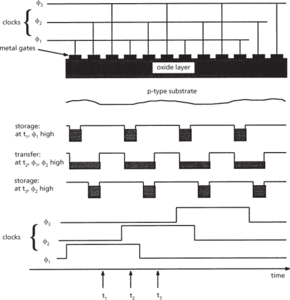See CCD.
A silicon chip containing an array of light-sensitive diodes, used for capturing images. The photodiodes, arranged in an array of rows and columns, become charged when light falls on them. The amount of charge depends on the amount of light, which may be built up over time. These charges are read out column by column to provide an analogue signal of the image on the array, which is then converted to digital form for display and storage on a computer. The image can be displayed almost immediately after the end of the exposure, and image processing can be used to enhance it. CCDs supplanted traditional photographic emulsions for astronomical use in the 1980s and 1990s. Modern CCDs used on survey telescopes contain over a billion pixels and are larger than traditional photographic plates.
A device for forming images electronically, using a layer of silicon that releases electrons when struck by incoming light. The electrons are stored in pixels and read off into a computer at the end of the exposure. CCDs are used in digital cameras, and have now almost entirely replaced photographic film for applications such as astrophotography, where extreme sensitivity to light is paramount.
See CCD.
An array of closely spaced MOS capacitors. Information is represented as a packet of charge stored in a capacitor, rather than as a voltage or current. In operation, this charge can be transferred from capacitor to capacitor in a controlled manner by application of a suitable sequence of voltage pulses to the capacitors: the CCD behaves like an analogue shift register. Typically a three-phase clock sequence is used (see diagram): every third electrode is clocked synchronously to maintain a physical separation between the charge packets, minimizing corruption of the data packets. Some charge is lost during each transfer due to recombination at the surface, diffusion out of the capacitor, etc., and so the data must be restored periodically along the array.
CCDs can be used for signal processing applications, such as transversal filters, and in imaging applications, where the MOS capacitors are charged by exposure to light or other electromagnetic radiation and the image data is then read out in a serial manner.

Charge-coupled device: operation of the three-phase clock for data transfer
A light-sensitive semiconductor used to enhance images obtained from faint objects. It accumulates and temporarily stores charge at particular pixel locations when struck by photons. The pixels can then be moved, allowing them to be pieced together to form an image.
- Mohs scale
- Mohs’ scale
- Mohs’s scale of hardness
- Moh’s scale
- Moh’s scale of hardness
- Moi, Daniel arap (1924–2020)
- moiety
- Moinian
- moiré pattern
- Moissan, Ferdinand Frédéric Henri
- moissanite
- moist coniferous forest
- moisture
- moisture balance
- moisture budget
- moisture content
- moisture index
- Moivre, Abraham De
- Mokoiwian
- Mokolian
- moksha
- MOL
- mol
- molal concentration
- molality